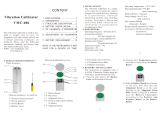
123B/124B/125B
Calibration Manual
6
AC coupled with 1:1 (shielded) test leads
60 Hz (6 Hz with 10:1 probe) ....................-1.5 %
50 Hz (5 Hz with 10:1 probe) ....................-2 %
33 Hz (3.3 Hz with 10:1 probe) .................-5 %
10 Hz (1 Hz with 10:1 probe) ....................-30 %
Note
For the total accuracy for AC coupled, add the derating values specified in the table to
the table of AC or DC coupled.
DC Rejection (only VAC).....................................>50 dB
Common Mode Rejection (CMRR) .....................>100 dB @ DC
>60 dB @ 50 Hz, 60 Hz, or 400 Hz
Full Scale Reading..............................................5000 counts, reading is independent of any signal crest factor.
Peak
Modes .................................................................Max peak, Min peak, or pk-to-pk
Ranges................................................................500 mV, 5 V, 50 V, 500 V, 2200 V
Accuracy
Max peak or Min peak.....................................5 % of full scale
Peak-to-Peak ..................................................10 % of full scale
Full Scale Reading..............................................500 counts
Frequency (Hz)
Ranges
125B, 124B .....................................................1 Hz, 10 Hz, 100 Hz, 1 kHz, 10 kHz, 100 kHz,1 MHz, 10 MHz, and 70 MHz
123B................................................................1 Hz, 10 Hz, 100 Hz, 1 kHz, 10 kHz, 100 kHz,1 MHz, 10 MHz, and 50 MHz
Frequency Range in Continuous Autoset ...........15 Hz (1 Hz) to 50 MHz
Accuracy
125B, 124B
@ 1 Hz to 1 MHz .............................................±(0.5 % + 2 counts)
@ 1 MHz to 10 MHz........................................±(1.0 % + 2 counts)
@ 10 MHz to 70 MHz......................................±(2.5 % + 2 counts)
123B
@ 1 Hz to 1 MHz .............................................±(0.5 % + 2 counts)
@ 1 MHz to 10 MHz........................................±(1.0 % + 2 counts)
@ 10 MHz to 50 MHz......................................±(2.5 % + 2 counts)
(50 MHz in Autorange)
Full Scale Reading..............................................10 000 counts
RPM
Max reading ........................................................50.00 kRPM
Accuracy.....................................................................±(0.5 % + 2 counts)
Duty Cycle (PULSE)
Range..................................................................2 % to 98 %
Frequency Range in Continuous Autoset ...........15 Hz (1 Hz) to 30 MHz
Accuracy (Logic or Pulse waveforms)
@ 1Hz to 1 MHz...................................................±(0.5 % + 2 counts)
@ 1 MHz to 10 MHz ............................................±(1.0 % + 2 counts)
Pulse Width (PULSE)
Frequency Range in Continuous Autoset ...........15 Hz (1 Hz) to 30 MHz
Accuracy (Logic or Pulse waveforms)
@ 1 Hz to 1 MHz..................................................±(0.5 % + 2 counts)
@ 1 MHz to 10 MHz ............................................±(1.0 % + 2 counts)
Full Scale Reading..........................................1000 counts
Amperes (AMP)
with current clamp
Ranges............................................................same as VDC, VAC, VAC+DC, or PEAK
Scale Factors ..................................................0.1 mV/A, 1 mV/A, 10 mV/A, 100 mV/A, 400 mV/A, 1 V/A, 10 mV/mA
Accuracy .........................................................same as VDC, VAC, VAC+DC, or PEAK (add current clamp uncertainty)




















